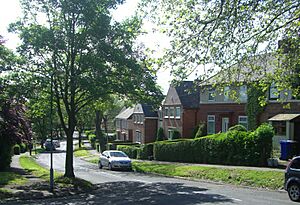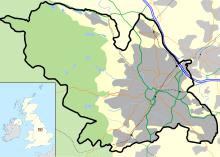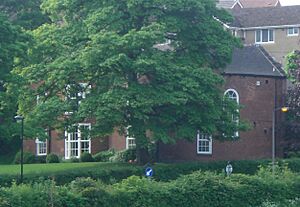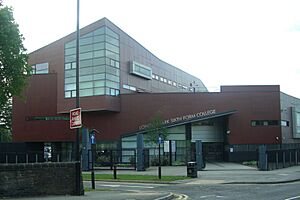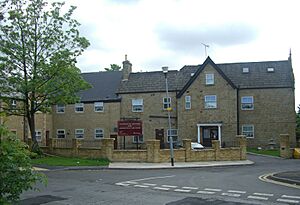Longley, Sheffield facts for kids
Longley is a neighbourhood in Sheffield, a city in South Yorkshire, England. It's about four kilometers (2.5 miles) north of the city center. Longley is mostly a place where people live, with many homes built by the Sheffield City Council in the late 1920s. It's part of the Firth Park area of the city.
Contents
History of Longley
The story of Longley goes back a long time, to the Late Middle Ages. The first time it was mentioned was in 1366. Back then, it was a small village called “Longeley,” which meant “Long Clearing.” Later, its name was spelled “Longlegh” and “Longlee.”
From the early 1400s, the few people living in Longley rented their land from the Earl of Shrewsbury. He was like the main landlord of the area. Most people worked on farms, growing crops and raising animals. Some also made small metal items, like cutlery.
In 1617, Longley became owned by Thomas Howard, 21st Earl of Arundel. His family later became the Dukes of Norfolk. As the Industrial Revolution began, farming in Longley became harder. The growing industries of Sheffield got closer and closer. In the early 1900s, Longley became part of Sheffield. It was chosen as a place to build many new council homes, and the old farming way of life disappeared.
Important Old Buildings
Before Longley became part of Sheffield, it had several large country houses. Most of these old houses have been taken down now.
Longley Hall
Longley Hall is on Longley Lane. It was built around 1780 for Kenyon Parker, a rich lawyer from Sheffield. This building is a Grade Two listed building, which means it's an important historic place. In the 1970s, it was damaged by vandals.
In 1980, a company bought the hall and fixed it up very well. Today, a private owner has the Hall. It is used as a supported living project, offering homes for people with different disabilities. The hall is surrounded by newer houses and is hard to see from the road. There is a special sign on the wall on Longley Lane.
Longley Hall Farm was next to the Hall. From 1906 to the 1950s, the farm provided fresh milk, meat, and vegetables for the nearby Northern General Hospital. The farm was taken down in 1969, and new homes were built on its land.
Crowder House
Crowder House was located where Crowland Road is now. It had very large gardens, and some of them became part of Longley Park. This was the oldest of Longley’s country houses. It was first mentioned in 1402.
The Wilkinson family owned the house for over 300 years. In 1855, they had to leave because a person renting the house went bankrupt. The family still had ties to the house until 1859. Then, a lawyer named Bernard Wake bought it. Crowder House was taken down in 1935, and new homes were built on its site.
The Brushes
The Brushes was at the corner of Longley Lane and Barnsley Road. It was built in 1790. However, a farm called Brushes Farm was on this spot in the 1640s, during the English Civil War. The first person who lived there, Captain Burley, was executed in 1646 for supporting the King's side (the Royalists).
The Booth family bought the farm in 1708. John Booth, who became rich from making iron and steel, built The Brushes mansion next to the farm in 1790. Charles Kayser bought it in 1888. He took down the farm and added a tower that looked like a castle to the mansion. In 1920, the building became Firth Park Grammar School after Sheffield Corporation bought it for £22,000. The building was taken down in 2002-2003. Now, Longley Park Sixth Form stands in its place.
Norwood Grange
Norwood Grange is at the corner of Herries Road and Longley Lane. It's a house with pointed roof sections, built in the 1850s. It was built for Thomas Fisher, who owned a company that made metal items called Britannia metal.
After several different owners, Sheffield Council bought the Grange just before World War II. During the war, it was used by the Auxiliary Fire Service and Air Raid Wardens as a base. After the war, the house became very run down. In the early 1990s, the main house was fixed up and made bigger. It became Norwood Grange Residential Home, a place for older people to live. Some of the smaller buildings around it are still in poor condition.
Cliffe House
Cliffe House stood on Elm Lane, where the Elm Lane Fire Station is now. Sarah Booth from The Brushes built the house in 1805. In 1934, it became The Cliffe Institute. In 1938, the Fire Station was built on its large grounds. The house stayed standing and was used as living quarters for the firefighters. The house was taken down right after World War II. The land was then used for building homes, and the houses on Hereward Road are now on that site.
Longley Today
In the early 1920s, Sheffield City Council started buying land in the Longley area. On June 10, 1926, the Council approved plans for 2,000 new homes in Longley. People started moving into these completed homes in 1927.
A school was built for the new neighbourhood on Raisen Hall Road. It officially opened on July 17, 1930. When it first opened, it could hold over 400 children. Longley Park was officially opened in 1929. It was created as a fun place for people living in the new area to relax and play.
Today, Longley has about 6,190 people living in 2,642 homes. More than half of the homes (53.3%) in Longley are rented from the local council. This is much higher than the average for all of Sheffield, which is 26.5%.
One of the newest housing projects in Longley is 20 bungalows built for older people on Everingham Place. The South Yorkshire Housing Association built these homes. Two of the bungalows are specially designed for people with disabilities. This project opened in December 2003.
The National Blood Service has its main office for the region in Longley. This center on Longley Lane processes, tests, and stores blood donations from the South Yorkshire area. Longley itself doesn't have any pubs right inside its borders. The closest one is the Devonshire Arms on Herries Road, which is in the next area called Shirecliffe.
Longley got its own church area, called St Leonards, Norwood, in 1929. The first stone for a new church on Everingham Road was laid in July 1939. But because of World War II, it wasn't finished and officially opened until May 1950.


